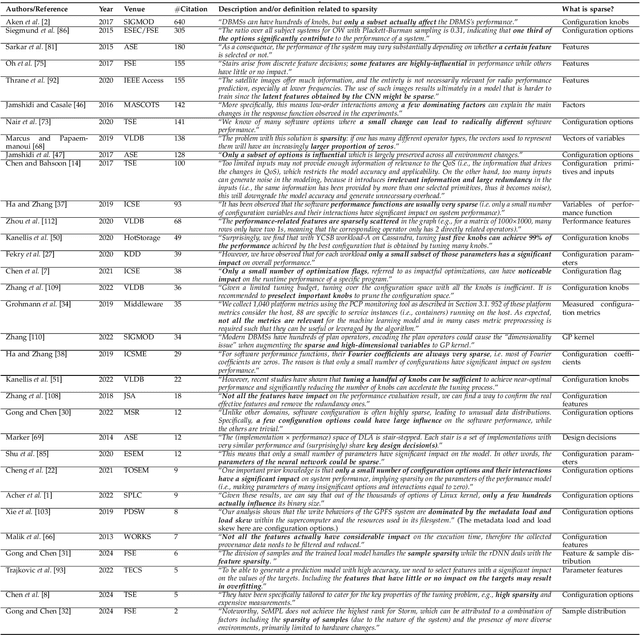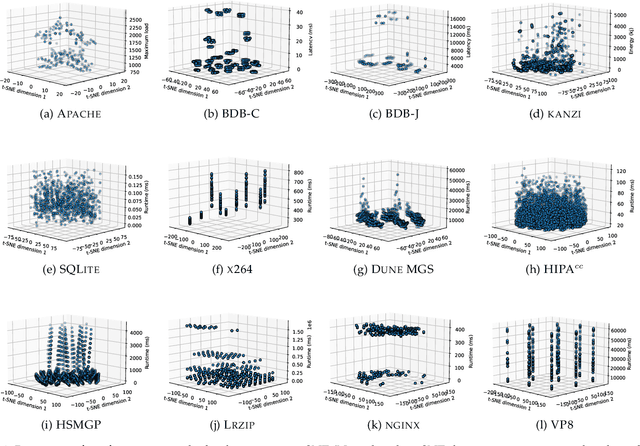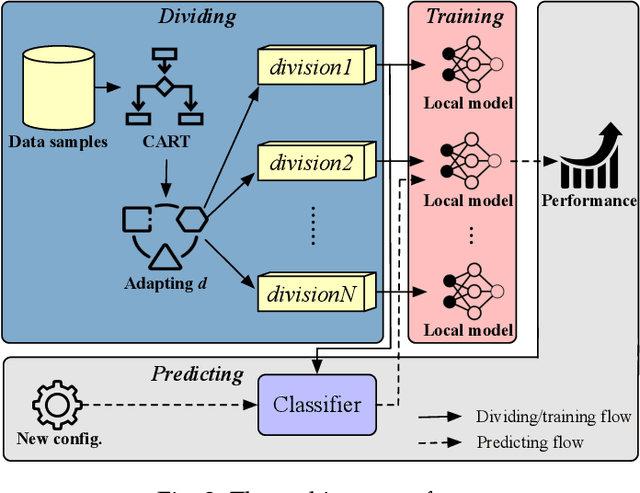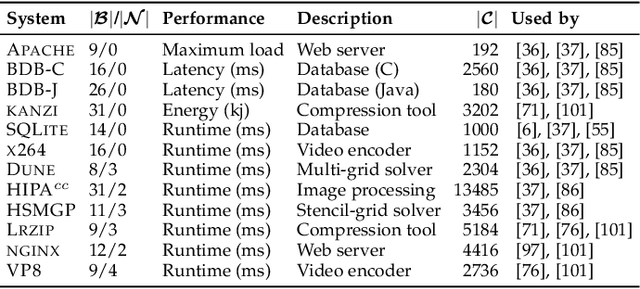Jingzhi Gong
Accuracy Can Lie: On the Impact of Surrogate Model in Configuration Tuning
Jan 03, 2025



Abstract:To ease the expensive measurements during configuration tuning, it is natural to build a surrogate model as the replacement of the system, and thereby the configuration performance can be cheaply evaluated. Yet, a stereotype therein is that the higher the model accuracy, the better the tuning result would be. This "accuracy is all" belief drives our research community to build more and more accurate models and criticize a tuner for the inaccuracy of the model used. However, this practice raises some previously unaddressed questions, e.g., Do those somewhat small accuracy improvements reported in existing work really matter much to the tuners? What role does model accuracy play in the impact of tuning quality? To answer those related questions, we conduct one of the largest-scale empirical studies to date-running over the period of 13 months 24*7-that covers 10 models, 17 tuners, and 29 systems from the existing works while under four different commonly used metrics, leading to 13,612 cases of investigation. Surprisingly, our key findings reveal that the accuracy can lie: there are a considerable number of cases where higher accuracy actually leads to no improvement in the tuning outcomes (up to 58% cases under certain setting), or even worse, it can degrade the tuning quality (up to 24% cases under certain setting). We also discover that the chosen models in most proposed tuners are sub-optimal and that the required % of accuracy change to significantly improve tuning quality varies according to the range of model accuracy. Deriving from the fitness landscape analysis, we provide in-depth discussions of the rationale behind, offering several lessons learned as well as insights for future opportunities. Most importantly, this work poses a clear message to the community: we should take one step back from the natural "accuracy is all" belief for model-based configuration tuning.
Dividable Configuration Performance Learning
Sep 11, 2024



Abstract:Machine/deep learning models have been widely adopted for predicting the configuration performance of software systems. However, a crucial yet unaddressed challenge is how to cater for the sparsity inherited from the configuration landscape: the influence of configuration options (features) and the distribution of data samples are highly sparse. In this paper, we propose a model-agnostic and sparsity-robust framework for predicting configuration performance, dubbed DaL, based on the new paradigm of dividable learning that builds a model via "divide-and-learn". To handle sample sparsity, the samples from the configuration landscape are divided into distant divisions, for each of which we build a sparse local model, e.g., regularized Hierarchical Interaction Neural Network, to deal with the feature sparsity. A newly given configuration would then be assigned to the right model of division for the final prediction. Further, DaL adaptively determines the optimal number of divisions required for a system and sample size without any extra training or profiling. Experiment results from 12 real-world systems and five sets of training data reveal that, compared with the state-of-the-art approaches, DaL performs no worse than the best counterpart on 44 out of 60 cases with up to 1.61x improvement on accuracy; requires fewer samples to reach the same/better accuracy; and producing acceptable training overhead. In particular, the mechanism that adapted the parameter d can reach the optimal value for 76.43% of the individual runs. The result also confirms that the paradigm of dividable learning is more suitable than other similar paradigms such as ensemble learning for predicting configuration performance. Practically, DaL considerably improves different global models when using them as the underlying local models, which further strengthens its flexibility.
GreenStableYolo: Optimizing Inference Time and Image Quality of Text-to-Image Generation
Jul 20, 2024Abstract:Tuning the parameters and prompts for improving AI-based text-to-image generation has remained a substantial yet unaddressed challenge. Hence we introduce GreenStableYolo, which improves the parameters and prompts for Stable Diffusion to both reduce GPU inference time and increase image generation quality using NSGA-II and Yolo. Our experiments show that despite a relatively slight trade-off (18%) in image quality compared to StableYolo (which only considers image quality), GreenStableYolo achieves a substantial reduction in inference time (266% less) and a 526% higher hypervolume, thereby advancing the state-of-the-art for text-to-image generation.
Pushing the Boundary: Specialising Deep Configuration Performance Learning
Jul 02, 2024Abstract:Software systems often have numerous configuration options that can be adjusted to meet different performance requirements. However, understanding the combined impact of these options on performance is often challenging, especially with limited real-world data. To tackle this issue, deep learning techniques have gained popularity due to their ability to capture complex relationships even with limited samples. This thesis begins with a systematic literature review of deep learning techniques in configuration performance modeling, analyzing 85 primary papers out of 948 searched papers. It identifies knowledge gaps and sets three objectives for the thesis. The first knowledge gap is the lack of understanding about which encoding scheme is better and in what circumstances. To address this, the thesis conducts an empirical study comparing three popular encoding schemes. Actionable suggestions are provided to support more reliable decisions. Another knowledge gap is the sparsity inherited from the configuration landscape. To handle this, the thesis proposes a model-agnostic and sparsity-robust framework called DaL, which uses a "divide-and-learn" approach. DaL outperforms state-of-the-art approaches in accuracy improvement across various real-world systems. The thesis also addresses the limitation of predicting under static environments by proposing a sequential meta-learning framework called SeMPL. Unlike traditional meta-learning frameworks, SeMPL trains meta-environments in a specialized order, resulting in significantly improved prediction accuracy in multi-environment scenarios. Overall, the thesis identifies and addresses critical knowledge gaps in deep performance learning, significantly advancing the accuracy of performance prediction.
Deep Configuration Performance Learning: A Systematic Survey and Taxonomy
Mar 05, 2024Abstract:Performance is arguably the most crucial attribute that reflects the behavior of a configurable software system. However, given the increasing scale and complexity of modern software, modeling and predicting how various configurations can impact performance becomes one of the major challenges in software maintenance. As such, performance is often modeled without having a thorough knowledge of the software system, but relying mainly on data, which fits precisely with the purpose of deep learning. In this paper, we conduct a comprehensive review exclusively on the topic of deep learning for performance learning of configurable software, covering 948 searched papers spanning six indexing services, based on which 85 primary papers were extracted and analyzed. Our results summarize the key topics and statistics on how the configuration data is prepared; how the deep configuration performance learning model is built; how the model is evaluated and how they are exploited in different tasks related to software configuration. We also identify the good practice and the potentially problematic phenomena from the studies surveyed, together with insights on future opportunities for the field. To promote open science, all the raw results of this survey can be accessed at our repository: https://github.com/ideas-labo/DCPL-SLR.
Predicting Configuration Performance in Multiple Environments with Sequential Meta-learning
Feb 05, 2024Abstract:Learning and predicting the performance of given software configurations are of high importance to many software engineering activities. While configurable software systems will almost certainly face diverse running environments (e.g., version, hardware, and workload), current work often either builds performance models under a single environment or fails to properly handle data from diverse settings, hence restricting their accuracy for new environments. In this paper, we target configuration performance learning under multiple environments. We do so by designing SeMPL - a meta-learning framework that learns the common understanding from configurations measured in distinct (meta) environments and generalizes them to the unforeseen, target environment. What makes it unique is that unlike common meta-learning frameworks (e.g., MAML and MetaSGD) that train the meta environments in parallel, we train them sequentially, one at a time. The order of training naturally allows discriminating the contributions among meta environments in the meta-model built, which fits better with the characteristic of configuration data that is known to dramatically differ between different environments. Through comparing with 15 state-of-the-art models under nine systems, our extensive experimental results demonstrate that SeMPL performs considerably better on 89% of the systems with up to 99% accuracy improvement, while being data-efficient, leading to a maximum of 3.86x speedup. All code and data can be found at our repository: https://github.com/ideas-labo/SeMPL.
Predicting Software Performance with Divide-and-Learn
Jun 11, 2023



Abstract:Predicting the performance of highly configurable software systems is the foundation for performance testing and quality assurance. To that end, recent work has been relying on machine/deep learning to model software performance. However, a crucial yet unaddressed challenge is how to cater for the sparsity inherited from the configuration landscape: the influence of configuration options (features) and the distribution of data samples are highly sparse. In this paper, we propose an approach based on the concept of 'divide-and-learn', dubbed $DaL$. The basic idea is that, to handle sample sparsity, we divide the samples from the configuration landscape into distant divisions, for each of which we build a regularized Deep Neural Network as the local model to deal with the feature sparsity. A newly given configuration would then be assigned to the right model of division for the final prediction. Experiment results from eight real-world systems and five sets of training data reveal that, compared with the state-of-the-art approaches, $DaL$ performs no worse than the best counterpart on 33 out of 40 cases (within which 26 cases are significantly better) with up to $1.94\times$ improvement on accuracy; requires fewer samples to reach the same/better accuracy; and producing acceptable training overhead. Practically, $DaL$ also considerably improves different global models when using them as the underlying local models, which further strengthens its flexibility. To promote open science, all the data, code, and supplementary figures of this work can be accessed at our repository: https://github.com/ideas-labo/DaL.
Does Configuration Encoding Matter in Learning Software Performance? An Empirical Study on Encoding Schemes
Apr 01, 2022



Abstract:Learning and predicting the performance of a configurable software system helps to provide better quality assurance. One important engineering decision therein is how to encode the configuration into the model built. Despite the presence of different encoding schemes, there is still little understanding of which is better and under what circumstances, as the community often relies on some general beliefs that inform the decision in an ad-hoc manner. To bridge this gap, in this paper, we empirically compared the widely used encoding schemes for software performance learning, namely label, scaled label, and one-hot encoding. The study covers five systems, seven models, and three encoding schemes, leading to 105 cases of investigation. Our key findings reveal that: (1) conducting trial-and-error to find the best encoding scheme in a case by case manner can be rather expensive, requiring up to 400+ hours on some models and systems; (2) the one-hot encoding often leads to the most accurate results while the scaled label encoding is generally weak on accuracy over different models; (3) conversely, the scaled label encoding tends to result in the fastest training time across the models/systems while the one-hot encoding is the slowest; (4) for all models studied, label and scaled label encoding often lead to relatively less biased outcomes between accuracy and training time, but the paired model varies according to the system. We discuss the actionable suggestions derived from our findings, hoping to provide a better understanding of this topic for the community. To promote open science, the data and code of this work can be publicly accessed at https://github.com/ideas-labo/MSR2022-encoding-study.
 Add to Chrome
Add to Chrome Add to Firefox
Add to Firefox Add to Edge
Add to Edge